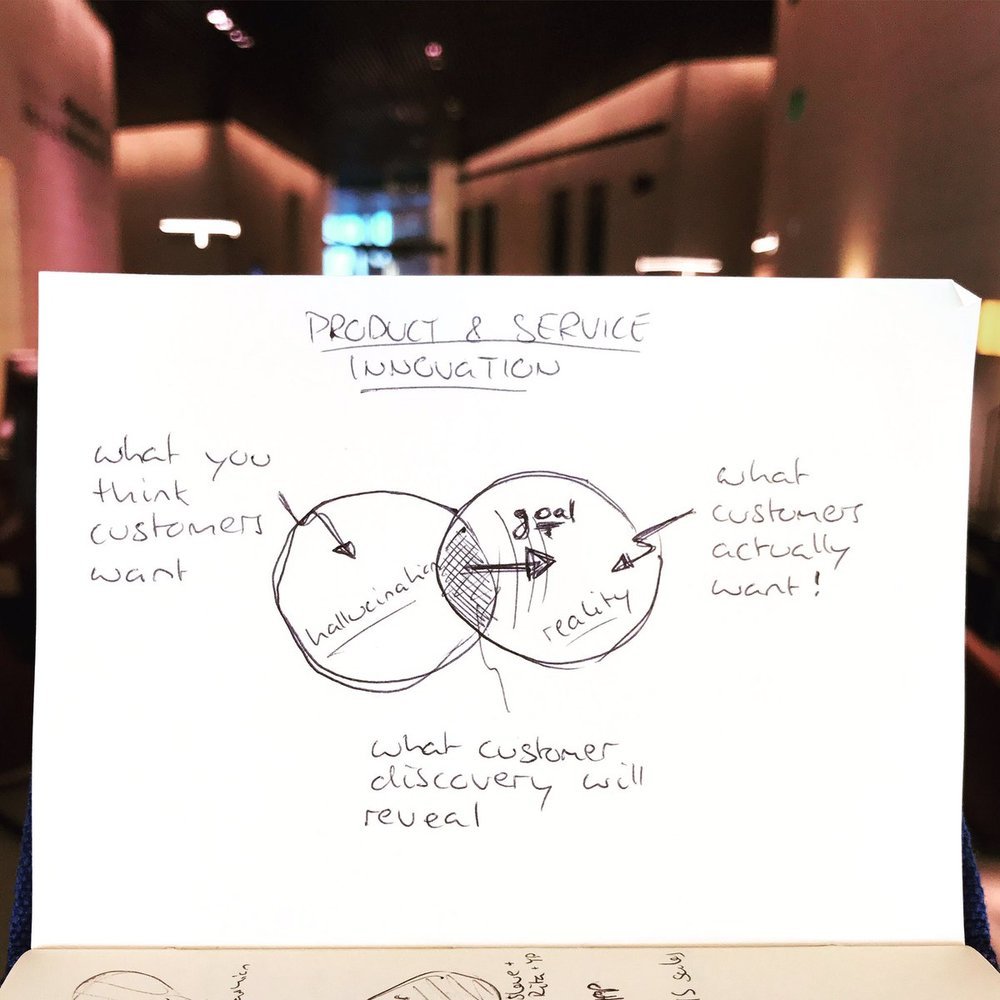Vision, hallucination, and customer reality
You may think you know what customers want; but until you test and gather evidence on their reality, you’ll just be following a hallucination.
Sometimes, we are so certain that we know what customers want, that we don’t think we need to test our ideas. In fact, the smarter and more experienced we are, the more likely we believe we are right. The more we rely on our opinion, the bigger the risk that we might be hallucinating. It’s only by testing, and Customer Discovery, that we unearth the customer reality.
The more you test and perform Customer Discovery, the more you increase the overlap between your (visionary) ideas and the reality of customer needs. Sometimes when you start out the overlap is bigger; sometimes it’s smaller. However, without testing, you don’t know with certainty.
Make testing a priority
Did you know that you can test many of your business assumptions without even building anything? Entrepreneurs and intrapreneurs often start building early versions of their products and services way too soon. The goal early on is to create the most learning as quickly and efficiently as possible. In this post we explain how to correctly build "Minimum Viable Products" (MVPs) so that you can maximize learning before even building your product or service.
Understand what customers want?
The challenge is, of course, to identify those products, services, and features that matter to customers. Uber, for example, helps people avoid the pain of searching for a cab or wasting time searching for one. Skype eliminated horrendously high fees for international calls.
It’s important to remember that no value proposition can possibly address every problem or desire for your customer. You can, however, prioritize the products, services, and features that will be most valuable to them. This isn’t about asking your customers what features are important to them; it’s about integrating them into the experiment, and getting them to help you decide from the start.
Product box
Action: Get your customers to design the package for a “non-existent” value proposition you have described to them.
Outcome: Discover the features that your customers desire by uncovering their jobs, pains, and gains.
Split your customers into groups. Give each group some cardboard and markers and ask them to design a package for the "non-existent" service you have just described.
This will encourage your customers to talk about the slogans, visuals, and features they would want to see on the package for this “imaginary” product.
Your customers must now sell back to you the idea that was originally described through the product boxes they have created. This is where your team must listen carefully and take notes.
Pay attention to what your customers are saying. This isn’t about recording the product they’ve created in their groups, it’s about the underlying jobs, pains, and gains that need to identified through your value proposition. These have to be plotted out in your value proposition canvas.
Some of the feature suggestions might sound impossible ( for example, an implant that can download the news to your brain); but if you pay attention to the underlying desire in the example I just gave (what are they trying to say?), you might instead notice that your customers just want an effortless way to consume the news everyday.
The buy-a-feature exercise
Action: Get your customers to collectively buy the features that interest them.
Outcome: Prioritize the features that customers crave the most.
Take the ideas that your customers suggested during the Product Box exercise and organize them into a feature list.
Price each potential feature according to its estimated development costs.
Give each customer a fixed, hypothetical budget so they can purchase their most desired features. Each individual must not have a budget big enough to buy their own features--instead, they have to collaborate with other members in their group to make a joint purchase.
Observe how the individuals negotiate for the features they want to purchase (why do some want to buy a feature, but others don’t?).
Make note of the features purchased, and point out why your customers were excited about their decisions. These could potentially be the features worth developing.
The two exercises above aren’t meant to produce a final roadmap for feature development. What these exercises really do are provide the cues that can potentially impact your value proposition, and reduce uncertainty around what your customers care about the most.
AHD Consulting Solution is here to help you with tools and insights to not just deal with these challenges but turn them into opportunities for innovation success. Accessible to corporations of any size, our sprints and programs include interactive workflows, videos, pre-structured workspaces, and much more. If you want to discuss a potential project, you can email on services@ahdconsultingsolution.com or get in touch with us here. Alternatively, you can book in a free 15-minute consultation call here.







